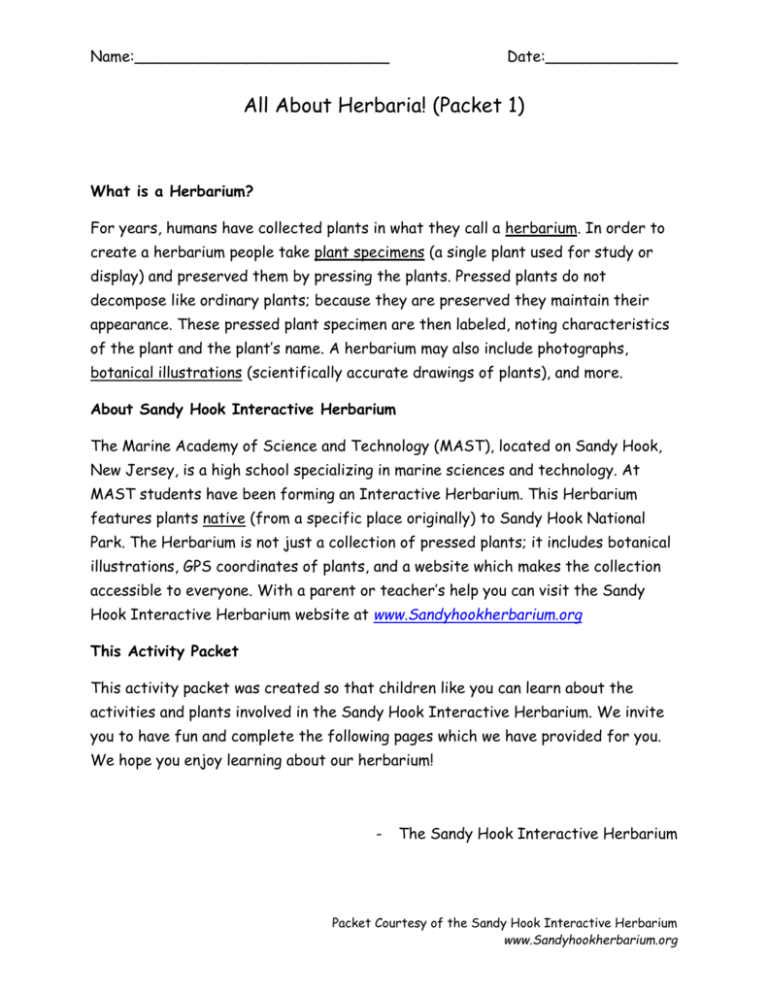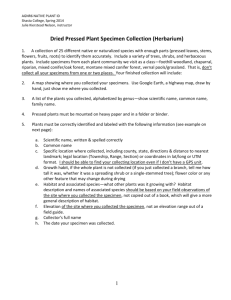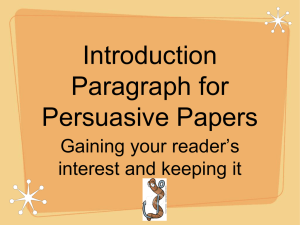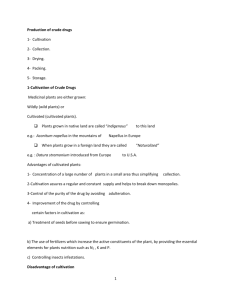Name: Date: All About Herbaria! (Packet 1) What is a Herbarium
advertisement

Name:___________________________ Date:______________ All About Herbaria! (Packet 1) What is a Herbarium? For years, humans have collected plants in what they call a herbarium. In order to create a herbarium people take plant specimens (a single plant used for study or display) and preserved them by pressing the plants. Pressed plants do not decompose like ordinary plants; because they are preserved they maintain their appearance. These pressed plant specimen are then labeled, noting characteristics of the plant and the plant’s name. A herbarium may also include photographs, botanical illustrations (scientifically accurate drawings of plants), and more. About Sandy Hook Interactive Herbarium The Marine Academy of Science and Technology (MAST), located on Sandy Hook, New Jersey, is a high school specializing in marine sciences and technology. At MAST students have been forming an Interactive Herbarium. This Herbarium features plants native (from a specific place originally) to Sandy Hook National Park. The Herbarium is not just a collection of pressed plants; it includes botanical illustrations, GPS coordinates of plants, and a website which makes the collection accessible to everyone. With a parent or teacher’s help you can visit the Sandy Hook Interactive Herbarium website at www.Sandyhookherbarium.org This Activity Packet This activity packet was created so that children like you can learn about the activities and plants involved in the Sandy Hook Interactive Herbarium. We invite you to have fun and complete the following pages which we have provided for you. We hope you enjoy learning about our herbarium! - The Sandy Hook Interactive Herbarium Packet Courtesy of the Sandy Hook Interactive Herbarium www.Sandyhookherbarium.org Name:___________________________ Date:______________ Vocabulary On this page you will match vocabulary terms with their meaning. Some of these terms have already been referred to, and others will be noted as you read on further. Vocabulary words throughout this packet are underlined, and their definitions are either provided (via parentheses like so) or are within the same sentence as the vocabulary word. Complete this page as you go through the packet. ___ Herbarium A. A single plant used for study or display ___ Native B. Scientifically accurate drawings of plants ___ Plant Specimens C. Device for pressing plants that is made from parallel pieces of wood perpendicular to other pieces of parallel wood. ___ Riker Box D. A collection of plants ___ Identify E. Used to pinpoint a location on a map ___ Plant Press F. From a specific place originally ___ Botanical Illustrations G. Information about a plant, like its name, that we did not know before. ___ GPS H. A special cardboard box with a glass front for viewing pressed plants Packet Courtesy of the Sandy Hook Interactive Herbarium www.Sandyhookherbarium.org Name:___________________________ Date:______________ Sandy Hook, New Jersey Sandy Hook National Park is located in New Jersey. The park has been developed as little as possible, allowing for native plants and animals to thrive. Because of this you will see many more different types of plants on Sandy Hook than you would in your own backyard. The Sandy Hook Interactive Herbarium has collected and pressed some of these plants, and has GPS (Used to pinpoint a location on a map) tagged locations of different plants on our website, so that you may see them for yourself. Color in the Sandy Hook Interactive Herbarium Logo! Packet Courtesy of the Sandy Hook Interactive Herbarium www.Sandyhookherbarium.org Name:___________________________ Date:______________ Different Plants of Sandy Hook The plants of Sandy Hook vary in size, shape, and color. Below are names and descriptions of different plants, On the following pages there are photos of the different plants which were described on this page. Cut out the photos and glue them to their matching name and description. Goldenrod (Also known as Canada Goldenrod) Tall plants with yellow/golden flowers at the top of their stems. The flowers themselves are small, but there are so many that they look like one big flower. Prickly Pear Cactus These cacti are not tall or found in the dessert. Instead they are found very small, low to the ground patches. They have prickly spires and sometimes a reddish/pinkish fruit found at the top of their broad leaves. Juniper These very fragrant plants can grow up to 60 feet tall! They have green scale-like leaves and many thin branches. Juniper also has blue berry-like cones which song birds like to eat. Bayberry (Also called Northern Bayberry) This plant has thin egg-shaped leaves as well as many thin branches which hold berries. The berries range from a blue to purple color and are edible. (Image goes here) (Image goes here) (Image goes here) (Image goes here) Packet Courtesy of the Sandy Hook Interactive Herbarium www.Sandyhookherbarium.org Name:___________________________ Date:______________ Packet Courtesy of the Sandy Hook Interactive Herbarium www.Sandyhookherbarium.org Name:___________________________ Date:______________ How are Plants Pressed? In order to create a herbarium, the first thing needed is plants specimens. We retrieve these at Sandy Hook by going outside and collecting plants on Sandy Hook, however this is not permitted for normal visitors; the Sandy Hook Interactive Herbarium has a permit to collect on Sandy Hook. Once the plant specimen have been collected we bring them back to our workspace, where we then remove access leaves and flowers so that the plant may be laid flat when it is later placed in the plant press. We then take out our plant press, which is device for pressing plants that is made from parallel pieces of wood perpendicular to other pieces of parallel wood. In order to use our plant press we first lay our plant specimen between two pieces of pressing paper, which This is a photo of the plant press, you can see the pieces of wood which compose the plant press and the straps which hold it together when in use. is a special type of paper used during plant pressing to help remove moisture from the plant. Then we sandwich that with pieces of cardboard. We then place these between the two pieces which make up the plant press, assuring that there are two pieces of cardboard at both ends before the plant press. When this task is complete, two straps go around the press and pulled as tight as possible. The plants must remain in the press for two weeks, and when the device is taken apart we are left with beautiful pressed plant specimen. Packet Courtesy of the Sandy Hook Interactive Herbarium www.Sandyhookherbarium.org Name:___________________________ Date:______________ Understanding a Plant Press Below is a simple diagram of a plant press. Some of the pieces have already been labeled. Label the rest of the plant press using the different patterns as a guide! Wooden Plant Press Cardboard Plant Pressing Paper Packet Courtesy of the Sandy Hook Interactive Herbarium www.Sandyhookherbarium.org Name:___________________________ Date:______________ Presenting a Plant After a plant is pressed it must be placed in a riker box for presentation. A riker box is a special cardboard box with a glass front for viewing pressed plants. We place the plants in their riker boxes with two silica gel packets (those packets you will find in new bags and other items that say “Throw away, do not eat”. The silica packets are used to prevent any moisture from accumulating in the riker box. Identifying a Plant When we do not know the name of a plant we have pressed we need to identify it. When we identify a plant we learn information about a plant, like its name, that we did not know before. To identify a plant we sit with the pressed specimen, and a group of plant books. Then using these books we match the plant specimen with the matching plant description in one of the books. This can be very time consuming, be it is vital to the herbarium and crucial to be done accurately. Labeling a Plant Once a plant is placed in a riker box and has been identified it is labeled. Labeling a plant includes the plant’s scientific name, common name, and other important information. A label is then printed out, and included in the riker box display for that plant. The plants are also labeled with a QR-code, which allows viewers to locate the webpage for that plant on our website with ease. Color the Prickly Pear Cactus Packet Courtesy of the Sandy Hook Interactive Herbarium www.Sandyhookherbarium.org






